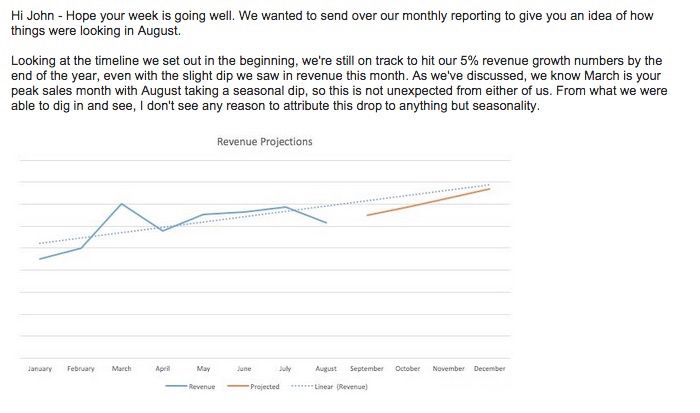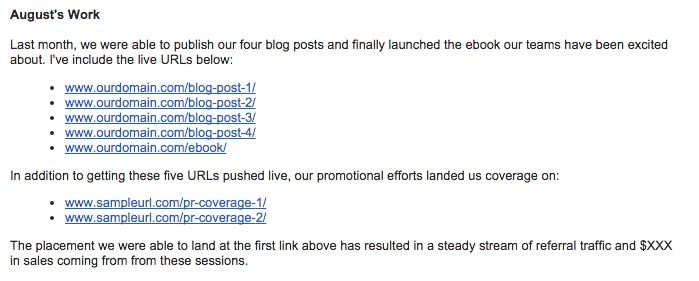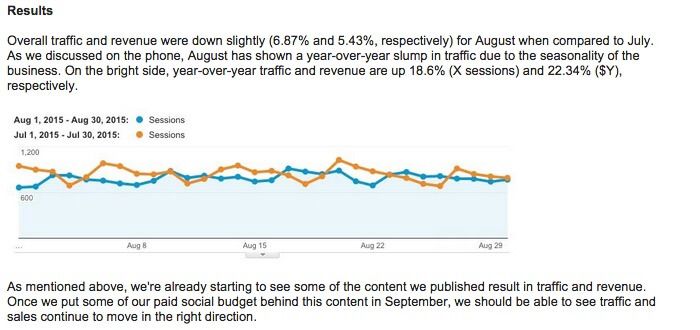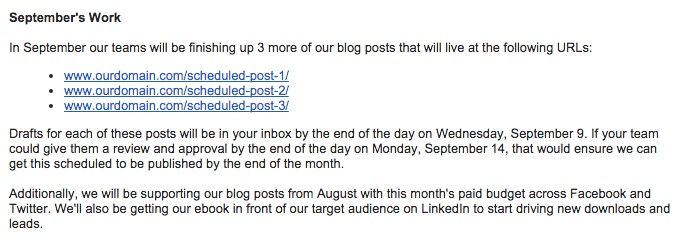Reporting is a continuous work in progress for our team at Content Harmony. We are constantly looking for ways to minimize time spent reporting while maximizing client insights and takeaways. The more time we spend each month on reporting is less time we get to execute on strategy.
With that being said, reporting at the end of or beginning of each month is a valuable time for our team to reflect on accomplishments and take a hard look at what’s working, and sometimes not working. Since so much time and energy goes into reporting, we work to make it as valuable and action-oriented as possible with clear next steps for the client. A good client report needs a good structure, just like a successful meeting needs a good meeting agenda.
In order to make sure our reports hit our clients’ desk, rather than disappear into the depths of their email archives, we’ve come up with our 9 ways to writing a report your boss will give a damn about:
Overview:
- 1. Restate Project Goals
- 2. What Did You Accomplish Last Month?
- 3. What Results Did You See From Your Work?
- 4. Tie KPIs To Business Goals
- 5. Explain Yourself
- 6. What Will Be Accomplished This Month?
- 7. Tell Them What To Do Next
- 8. Call the Client. Have a Conversation
- 9. Focus on “We”
1. Restate Project Goals
What goals did you set out to accomplish at the beginning of the project? Monthly reporting is an excellent time to stop and look at where you are versus where you intend to be. Are you ahead of schedule? Behind?
If you’re ahead of projected traffic, revenue, sales, etc., understand what you’ve done to get there and how you can carry the momentum through the end of the project or contract.
If you’re behind, take this time to reflect on what you’ve accomplished so far and what you can do differently moving forward to catch up. Use this monthly report as a check-in point to understand whether or not you need to pivot your strategy.

2. What Did You Accomplish Last Month?
Sure, it sounds pretty straightforward, but you’d probably be surprised at how many reports I’ve seen that left this fairly vague.
Are you a content marketing agency that focuses on production and distribution? What content did you publish last month? Where did you publish it? How did you get the content in front of your clients’ target customers? How much did you spend to do so?
Are you a PR agency? Did you get any notable placements for your client? Did you make any new contacts you can use for future projects?
Make sure these are things you can point to and say “that… we did that.”
If you don’t have any tangible work to point to, I’d probably be ready to explain where time and resources were spent. Understandably, there are months spent working on strategy and planning that won’t always amount to tangible products. If that’s the case, make this crystal clear and point to any deliverables (or work in progress documents) you have created along the way.

3. What Results Did You See From Your Work?
Was it successful? When you look at everything you’ve accomplished last month, did it get your client closer to reaching their business goals and the goals your team set out to hit at the beginning of the project?
At the beginning of each project, your team should sit down with the client and carefully outline key performance indicators (KPIs) that will be reported each month. When it comes down to reporting, your team should examine each one of these KPIs and report how your work directly impacted KPI movement (positively or negatively).

4. Tie KPIs To Business Goals
Building upon showing your results, make sure KPIs reported are tied to business growth goals, not arbitrary, meaningless metrics.
Depending on the client, KPIs will likely be very different. Lead generation-focused clients will want to see new leads acquired, e-commerce clients will want to see new revenue and sales, publishers tend to care most about page views, etc.
Whatever the case, make sure KPIs are aligned with business goals, typically meaning more money coming through the door for your client. Things like search rankings and PR placements are great leading indicators that should be identified but are typically not KPIs to highlight.
Bonus Tip: Don’t report on things that don’t matter. For example, if you’re working with a lead gen client and one month you have a large growth in pageviews, ask yourself “does this really matter or am I just reporting these numbers because they are positive?”
It’s easy, especially when KPIs may be down from time-to-time, to report on other metrics purely because they look good. Avoid this. If you can’t reasonably make the conclusion that a metric contributes to the overall business goals, omit it completely. Otherwise, you’re likely setting yourself up for client questions you may not be prepared to answer.
5. Explain Yourself
Are numbers and KPIs up for the month? Are they down? Take this chance to really dive into the ‘why,’ regardless which direction things are trending.
If numbers are moving in the right direction, take time to let the client know exactly what you’ve done to achieve this. Did you publish a blog post that went viral? Is your whitepaper generating more leads than your client has ever seen? Take credit for that.
If your numbers are down, first take a chance to understand why. Maybe it’s a seasonal trend or maybe your hard work just didn’t amount to what you thought it would. Once you understand what’s going on, create a plan of action to pivot and change this next month.
Carefully communicate the reason behind the drop along with your plan to improve this in coming months. From my experience, clients understand not every month will be a home run and there will be dips along the way. As long as you and your team have a plan to correct this, most clients will be willing to continue working toward improvement.
6. What Will Be Accomplished This Month?
Again, something that should be pretty straightforward, but often gets neglected; usually in the case when there isn’t a clear plan of action.
At Content Harmony, we typically work in 6-12 month cycles. We’ll spend time creating a strategy and planning for 6-12 months of work at a time with a clear timeline of deliverables and goals. This timeline is always communicated with the client up front, but it is always good to restate the every month along with reporting.
After you covered accomplishments in the previous month along with the results you’ve seen, dive into the plan for the next month. Always include tasks, deliverables, and due dates. Not only will this ensure the client that you are on top of things, but this will keep your own internal team accountable for hitting due dates and staying on schedule.

7. Tell Them What To Do Next
Clearly communicate next steps and action items for each person on your team, as well as the client’s. With so many emails and to-do lists bouncing around between both teams, it’s easy to lose track of tasks. Use monthly reporting to call out specific action items to be done by each team.

8. Call the Client. Have a Conversation.
Once you get monthly reporting out the door, set up a time to call or meet the client and discuss monthly reporting. Even 30 minutes to clear up any kind of questions can go a long way and continue to build upon your client/agency relationship.
Bonus Tip: Use this meeting to review action items needed from the client. Your client contact is likely a busy person and might still skim through the important parts (even if it’s one they should give a damn about). Make sure she/he knows what’s needed from them and when you need it.

Be sure to send comprehensive meeting minutes after each meeting so everyone knows next steps.
9. Focus on “We”
A client/agency relationship is just that, a relationship. As your client’s business grows, so does yours. You are both incentivized to do well and work together as a team. Make sure your reporting and communication reflects this teamwork.
Use “we” or “us” when talking about successes and accomplishments:
- “This month we were able to achieve XYZ.”
- “We saw X% improvement over last month.”
Keeping this in mind is one of those minor improvements that can reframe the work you’re doing and create lasting client/agency relationships.
Practice makes perfect. As mentioned above, this is an on-going process that you'll need to constantly refine as an agency in order to better serve your clients.
Each client is different and these points should help improve multiple types of reporting efforts.
✉️ Get an email when we publish new content:
Don't worry, we won't bug you with junk. Just great content marketing resources.
Ready To Try
Content Harmony?
Get your first 10 briefs for just $10
No trial limits or auto renewals. Just upgrade when you're ready.

You Might Also Like:
- The Wile E. Coyote Approach To Content Guidelines
- Content Brief Templates: 20 Free Downloads & Examples
- The Keyword Difficulty Myth
- How To Find Bottom of Funnel (BoFU) Keywords That Convert
- Bottom of Funnel Content: What Is BOFU Content & 10 Great Examples
- 20 Content Refresh Case Studies & Examples: How Updating Content Can Lead to a Tidal Wave of Traffic 🌊
- How to Create Editorial Guidelines [With 9+ Examples]
- Content Marketing Roles
- How To Write SEO-Focused Content Briefs
- The Content Optimization Framework: [Intent > Topic > UX]
- How To Update & Refresh Old Website Content (And Why)
- 12 Content Marketing KPIs Worth Tracking (And 3 That Aren't)
- 16 Best Content Writing Tools in 2024 (Free & Paid)
- How to Create a Content Marketing Strategy [+ Free Template]
- How To Create Content Marketing Proposals That Land The Best Clients
- What Is A Content Brief (And Why Is It Important)?
- How To Create A Dynamite Editorial Calendar [+ Free Spreadsheet Template]
- How to Use Content Marketing to Improve Customer Retention
- Types of Content Hubs: 5 Approaches & 30+ Examples
- How To Do A Content Marketing Quick Wins Analysis

